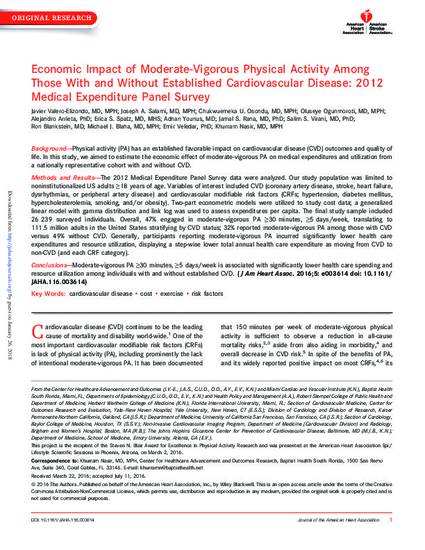
Background Physical activity (PA) has an established favorable impact on cardiovascular disease (CVD) outcomes and quality of life. In this study, we aimed to estimate the economic effect of moderate‐vigorous PA on medical expenditures and utilization from a nationally representative cohort with and without CVD.
Methods and Results The 2012 Medical Expenditure Panel Survey data were analyzed. Our study population was limited to noninstitutionalized US adults ≥18 years of age. Variables of interest included CVD (coronary artery disease, stroke, heart failure, dysrhythmias, or peripheral artery disease) and cardiovascular modifiable risk factors (CRFs; hypertension, diabetes mellitus, hypercholesterolemia, smoking, and/or obesity). Two‐part econometric models were utilized to study cost data; a generalized linear model with gamma distribution and link log was used to assess expenditures per capita. The final study sample included 26 239 surveyed individuals. Overall, 47% engaged in moderate‐vigorous PA ≥30 minutes, ≥5 days/week, translating to 111.5 million adults in the United States stratifying by CVD status; 32% reported moderate‐vigorous PA among those with CVD versus 49% without CVD. Generally, participants reporting moderate‐vigorous PA incurred significantly lower health care expenditures and resource utilization, displaying a step‐wise lower total annual health care expenditure as moving from CVD to non‐CVD (and each CRF category).
Conclusions Moderate‐vigorous PA ≥30 minutes, ≥5 days/week is associated with significantly lower health care spending and resource utilization among individuals with and without established CVD.
Available at: http://works.bepress.com/emir-veledar/24/

Originally published in the Journal of the American Heart Association.